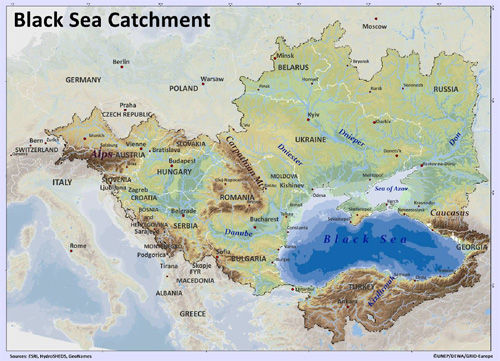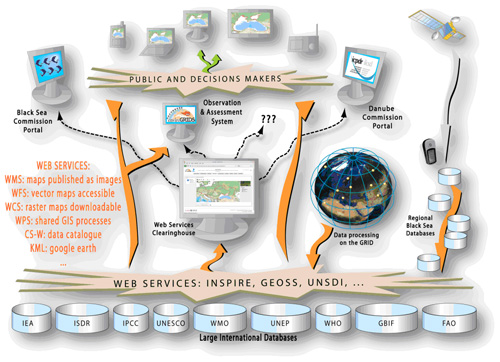|
|
|
|
Building Capacity for a Black Sea Catchment Observation and Assessment System
supporting Sustainable Development
EnviroGRIDS @ Black Sea Catchment
|
Coordinator: Dr. Anthony Lehmann
Management: Dr. Nicolas Ray
|
Duration: 4 years: April 2009 - March 2013
Funding: European Commission FP7
|
|
 Background Background
The Black Sea Catchment is internationally known as one of ecologically unsustainable development and inadequate resource management, which has led to severe environmental, social and economic problems. The EnviroGRIDS @ Black Sea Catchment project addresses these issues by bringing several emerging information technologies that are revolutionizing the way we observe our planet. The Group on Earth Observation Systems of Systems (GEOSS) is building a data-driven view of our planet that feeds into models and scenarios to explore our past, present and future. EnviroGRIDS aims at building the capacity of scientist to assemble such a system in the Black Sea Catchment, the capacity of decision-makers to use it, and the capacity of the general public to understand the important environmental, social and economic issues at stake.
Project Vision / Goals
EnviroGRIDS aims at building capacities in the Black Sea region to use new international standards to gather, store, distribute, analyze, visualize and disseminate crucial information on past, present and future states of this region, in order to assess its sustainability and vulnerability. To achieve its objectives, EnviroGRIDS will build a Grid-enabled Spatial Data Infrastructure (GSDI) becoming one of the integral systems in the Global Earth Observation System of Systems (GEOSS), and compatible with the new EU directive on Infrastructure for Spatial Information in the European Union (INSPIRE), as well as UNSDI developments.
The scientific aim of the EnviroGRIDS @ Black Sea Catchment project is to start building an Observation System that will address several GEO Societal Benefit Areas within a changing climate framework. This system will incorporate a shared information system that operates on the boundary of scientific/technical partners, stakeholders and the public. It will contain an early warning system able to inform in advance decision-makers and the public about risks to human health, biodiversity and ecosystems integrity, agriculture production or energy supply caused by climatic, demographic and land cover changes on a 50-year time horizon.
 Main outcomes Main outcomes
- a gap analysis of existing regional observation systems to prepare recommendations for improvement of networks for data acquisition in the region/country,
- an improved regional network to coordinate the efforts of partners active in observation systems
- a spatial data infrastructure to link, gather, store, manage and distribute key environmental data,
- real-time access sensors and satellites data,
- spatially explicit scenarios of key changes in land cover, climate and demography,
- grid-enabled spatial data infrastructure for large calculations and datasets,
- streamlined production of indicators on sustainability and vulnerability of societal benefits,
- early warning and decision support tools at regional, national and local levels,
- capacities developed in the implementation of many new SDI frameworks (INSPIRE, GEOSS, UNSDI,..).
|